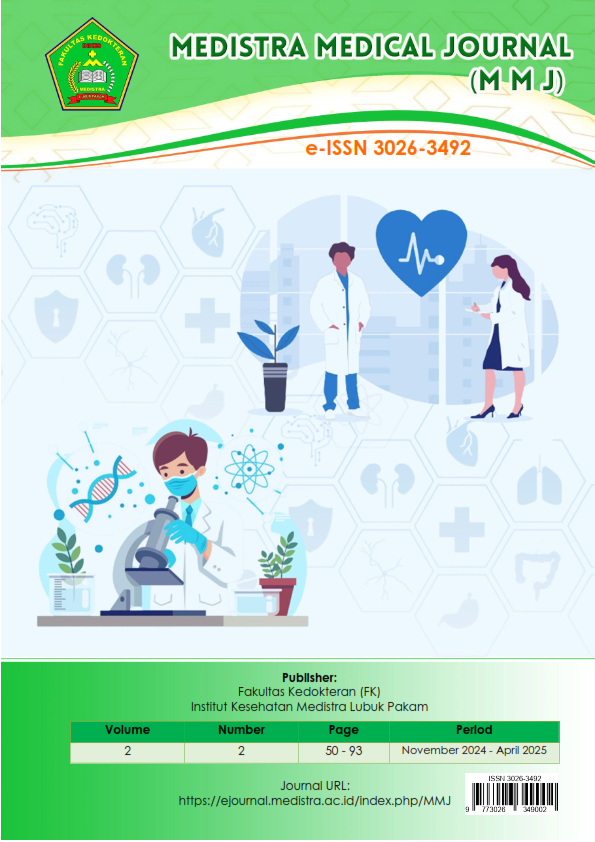Implementation of the Hospital Surge Capacity Model in Catastrophic Emergency Management at Sembiring Deli Tua General Hospital in 2023
DOI:
https://doi.org/10.35451/s8y6t002Keywords:
Hospital Surge Capacity; Disaster Management; Emergency; Hospital; Sembiring Deli Tua General Hospital.Abstract
Disasters are a public health threat that can occur suddenly and cause a surge of patients exceeding the normal capacity of hospitals. This condition requires hospitals to have integrated preparedness through the concept of Hospital Surge Capacity (HSC), which consists of four main components: staff, stuff, structure, and system. This study aims to analyze the implementation of the HSC model in catastrophic emergency management at Sembiring Deli Tua General Hospital in 2023. The research design used a mixed-methods approach with a sequential explanatory strategy, beginning with the collection of quantitative data through questionnaires distributed to 85 health workers in the Emergency Department, followed by qualitative data collection through in-depth interviews with 10 key informants and field observations. Quantitative data were analyzed descriptively, while qualitative data were analyzed thematically to enrich the findings.
The results show that in terms of staff, about 80% of medical personnel are considered sufficient and 65% have participated in emergency training such as BLS, ACLS, BTCLS, and PPGD, although there are still shortages of critical specialists. For stuff, the availability of emergency drugs is adequate (70%), but only 8 ventilators are available and the blood supply is limited, making the hospital unprepared for mass casualties. Regarding structure, the Emergency Department has 12 beds which are often full, disaster isolation rooms are not yet available, and ambulance access is limited. In terms of system, the hospital already has disaster SOPs, applies the START triage system, and has established fairly good external coordination; however, the last disaster simulation was conducted in 2021 and communication facilities remain limited. Overall, the implementation of HSC at Sembiring Deli Tua General Hospital in 2023 falls into the moderately prepared category, with strengths in human resources and management systems, but significant weaknesses in logistics and physical facilities. These findings highlight the need to strengthen the capacity of critical medical equipment, provide disaster isolation rooms, enhance advanced training, and conduct regular disaster simulations so that hospitals can respond optimally to catastrophic emergencies.
References
[1] WHO. Hospital preparedness for emergencies. Geneva: World Health Organization; 2020.
[2] Barbisch DF, Koenig KL. Understanding hospital surge capacity: Essential elements. Acad Emerg Med. 2020;27(4):353-9.
[3] Patel R, Kumar S. Hospital emergency response planning: A systematic review. J Emerg Health. 2023;12(1):23-30.
[4] Kemenkes RI. Pedoman Penanggulangan Bencana di Rumah Sakit. Jakarta: Kementerian Kesehatan Republik Indonesia; 2021.
[5] Lestari W, Nugroho H, Sari DN. Hospital preparedness in disaster management: A systematic review. J Health Policy Manag. 2022;7(2):112-20.
[6] Chen CY, Chang HC, Cheng CF. Surge capacity management in Taiwan hospitals during disaster. Int J Disaster Risk Reduct. 2020;47:101547.
[7] Prasetyo A, Wulandari R, Handayani O. Hospital preparedness and surge capacity during floods in Central Java. J Disaster Manage. 2021;9(2):89-96.
[8] Rizki M, Sari P, Utami A. Challenges in hospital disaster preparedness in Indonesia: A qualitative study. BMC Health Serv Res. 2022;22:1056.
[9] WHO. Hospital Preparedness for Emergencies. Geneva: World Health Organization; 2018.
[10] Suryani E, et al. Disaster Preparedness among Healthcare Workers in Indonesia. BMC Health Services Research. 2019;19(1):897.
[11] Nugroho S, et al. Evaluasi Kesiapan Rumah Sakit dalam Menghadapi Bencana di Indonesia. Jurnal Kesehatan Masyarakat. 2020;15(2):123–132.
[12] Kaji AH, Koenig KL, Bey T. Surge Capacity for Healthcare Systems: A Conceptual Framework. Academic Emergency Medicine. 2006;13(11):1157–1159.
[13] Chiu CH, et al. Hospital Preparedness and Surge Capacity Response to Disasters. Taiwan Journal of Public Health. 2019;38(2):117–124.
Downloads
Published
Issue
Section
License
Copyright (c) 2025 Simion Sembiring

This work is licensed under a Creative Commons Attribution 4.0 International License.
Copyright in each article is the property of the Author.
















